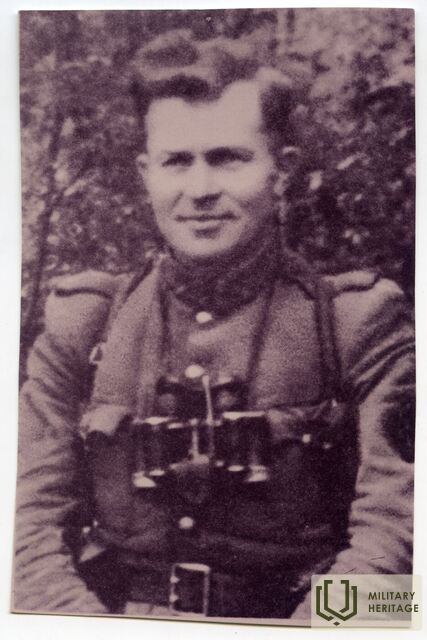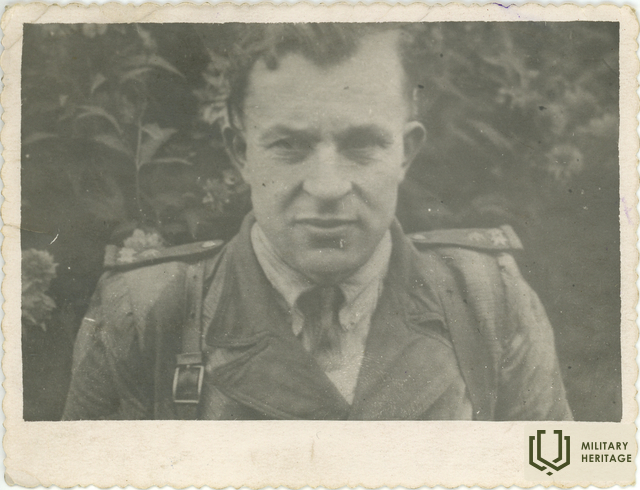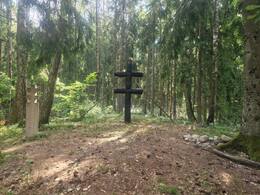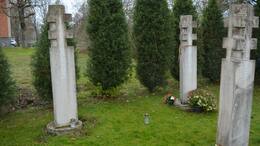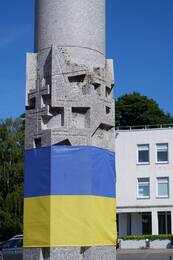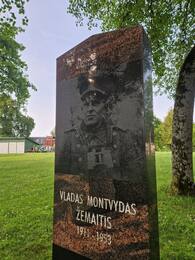Vlads Montvīds-Žemaitis III Nacionālie partizāni
Vlads Montvīds (iesaukās Žemaitis, Etmonas, Algimantas, Dėdė) dzimis 1911. gada 9. septembrī Telšu apriņķa Varņu pagasta Gatautisku ciemā. Viņa vecāki bija Gatautišķu muižas strādnieki. Pēc Požeres pamatskolas beigšanas Vladas apguva galdnieka arodu. Dienojot Lietuvas armijā, 1934. gadā beidzis apakšvirsnieku skolu un kļuvis par seržantu. Aktīvi piedalījies sabiedriskajās aktivitātēs, bijis Strēlnieku savienības biedrs un strēlnieku rotas komandieris. 1938. gadā viņš apprecējās ar septiņpadsmitgadīgo zemnieka meitu Broņislavu Ralyti un kļuva par 20 hektāru lielas saimniecības īpašnieku. Montvīdam izdevās atdzīvināt pamesto saimniecību - viņš attīstīja brikšņu ražošanu, iegādājās graudu kulšanas iekārtas un zirgu graudu dzirnavas. Viņi uz mājas jumta uzstādīja vēja ģeneratoru, lai ražotu elektrību, un ierīkoja jaunu dārzu.
Tuvojoties otrajai padomju okupācijai, V. Montvīds izvēlējās aizstāvēt savu dzimteni. 1944. gada sākumā Varņu apkaimē sāka organizēt Lietuvas Brīvības armijas Vanagu grupu. Viņa mājā tika doti zvēresti un slepeni nēsāti ieroči. 1944. gada jūlijā viņš kopā ar savu biedru Stasi Beniuli devās uz Plateļu mežiem, lai apmācītu jauniešus. Montvīds ierīkoja pirmos trīs partizānu slēptuves, kā rezultātā padomju varas iestādes 1944. gada Ziemassvētku vakarā nodedzināja viņa sētu. Viņa sieva un pieci mazi bērni palika bez pajumtes, un viņus patvēra radinieki un zemnieki no Žemaitijas ciemiem.
No 1945. gada augusta Montvīds bija Šatrias komandas biedrs, bet 1947. gadā tika iecelts par tās komandieri. 1948. gada ziemā kopā ar Žemaitijas apgabala komandieri A. Milaševiču atjaunoja apgabala štābu, kļuva par tā priekšnieku un no 1948. gada jūnija par apgabala komandieri. Šo amatu viņš ieņēma visilgāk no visiem Lietuvas partizānu apriņķa komandieriem – 5 gadus un 3 mēnešus. Viņš bija Lietuvas Brīvības cīņas kustības Bruņoto spēku padomes loceklis.
V. Montvīds lielu uzmanību pievērsa partizānu presei. Ar viņa gādību Žemaitijas apgabalā iznāca laikraksti "Cīņas lietuvietis", "Lūgšana mežā" (1951-1952), "Brīvības balss" (1945-1953). 1952. gadā tika izdots dzejoļu krājums "Brīvības cīņu atbalsis" 1000 eksemplāru tirāžā.
1951. gadā Montvīda sieva tika arestēta un ieslodzīta Džekazganā, Kazahstānā. 1953. gada 23. augustā Reistru ciemā pie Lūkstas ezera pie Sietuvas strauta kopā ar savu adjutantu B. Alūzu-Bedali tika nogalināts Šilales rajona iedzīvotāja nodotais Vlads Montvyds. Tiek uzskatīts, ka pēc divu stundu apšaudes ar iekšējiem karaspēkiem un nemieru policiju abi nošāvās paši. Viņu līķi tika apgānīti Varniai Stribai galvenās mītnes pagalmā.
Pēcnāves laikā V. Montvīdam tika piešķirti augsti apbalvojumi: 1997. gadā – brīvprātīgā karavīra statuss, 1998. gadā – pulkveža pakāpe, 1999. gadā – Vytis krusta ordeņa komandiera krusts. 1994. gadā Kaltinėnu apkaimē tika atrasta kārba, kurā atradās V. Montvīda-Žemaiša arhīvs, kas tagad glabājas Lietuvas speciālajā arhīvā.
Papildus izziņas avoti
Saistītās laikalīnijas
Saistītie objekti
Lietuvas Brīvības armijas partizānu "Vanagi" apmācības un šaušanas nometne Plokštinē
Lietuvas Brīvības armijas (LLA) partizānu apmācības un šaušanas nometne, kas pazīstama kā "Vanagu" nometne, tika izveidota Žemaitijā, Plokštines mežos, netālu no Platēlijas. Šī nometne bija nozīmīga LLA struktūras sastāvdaļa, kur partizāni trenējās cīņai pret padomju okupācijas varu.
Nometne dibināta 1944. gadā. augustā, kad Padomju Savienība otrreiz okupēja Lietuvu. Šeit "Vanagu" grupas dalībnieki apguva ne tikai šaušanas un partizānu kara taktiku, bet arī izdzīvošanas iemaņas dabā. Viņi gatavojās ilgstošai pretošanai mežos, lai varētu darboties slepeni un pēc iespējas efektīvāk organizēt uzbrukumus padomju struktūrām. Nometnē mācīja ne tikai bruņotu pretošanos, bet arī izlūkošanas, sakaru, maskēšanās un citas partizāniem nepieciešamās iemaņas.
Plakanie meži tika izvēlēti to blīvuma un attāluma dēļ, kas ļāva partizāniem slēpties no okupantiem. Nometnes aktivitātes galu galā aptvēra apkārtējos mežus ar sarežģītām partizānu takām, kuras padomju varai ilgu laiku bija grūti saprast. Šeit trenējās dažāda vecuma vīrieši un sievietes, tostarp bijušie šāvēji, karavīri un vienkāršie Lietuvas iedzīvotāji, kuri bija gatavi cīnīties par Lietuvas brīvību.
2019. gadā Plokštinjes mežā tika noteikts precīzs 1944. gads. 15.-25.augusts "Vanagu" militāro mācību norises vieta, ko apliecināja daudzu raidījumu vadītāju - militārās apmācības nometnes dalībnieku stāstu detaļas, jauni, līdz šim nezināmi dati par nometnes iekārtojumu un tajā dienējušo "Vanagu" saimniecību. tika savākti. Vietu izpētījis Gedimins Petrauskas.
Lai gan, apmeklējot vietu, šai nometnei nav īpašu zīmju, pagātnes vēstures notikumus atspoguļo joprojām atrastās patronas un lodes un to zīmes priedēs.
Piemineklis Alsēžu apkaimē kritušo Žemaičių apriņķa partizānu piemiņai
Piemineklis Alsēžu apkaimē paredzēts, lai godinātu Žemaiču rajona Alkas un Šatrijas apgabalu kritušos partizānus, kuri pēckara gados aktīvi cīnījās pret padomju okupāciju. Piemineklis piemin visus tos, kuri aizstāvēja Lietuvas brīvību un neatkarību šajā teritorijā, cīnoties pret daudz spēcīgākiem un labāk bruņotiem padomju spēkiem.
Piemineklis celts, lai pieminētu Alkas un Šatrijas izlašu cīnītājus, kuri šajā vietā 1944.-1953.gadā tika apglabāti ierakumos.
Piemineklis sastāv no tipisku partizānu memoriālu kompozīcijas. Autori ir dizainers Romas Navickas un arhitekte Viktorija Moliene. Piemineklis tika atklāts 2004. gadā. 29. augusts ar bijušā Žemaičių apriņķa Alkas izlases partizāna politieslodzīto Alfonso Norkaus-Žilvīša gādību.
Mūsdienās šis piemineklis ir viens no daudzajiem, kas atgādina partizānu pretošanos Žemaitijā un visā Lietuvā.
Piemineklis "Žemaišu apgabala partizānu piemiņai un brīvības cīņām"
Telšu Neatkarības laukumā stāvošais piemineklis ir veltīts Žemaitijas apgabala partizānu un Brīvības cīņu piemiņai. Interesanti, ka dažādās Lietuvas pilsētās ir uzstādīti iespaidīgi pieminekļi, lai pieminētu šajā reģionā darbojošos partizānu vienību darbību.
Žemaitijas reģions – 1945. gads Tika izveidots partizānu apgabals, kas apvienoja Lietuvas pretošanās kustības dalībniekus Telšu, Kretingas, Mažeiķu apriņķos un daļā Taurages apriņķa. Ziemeļrietumu Lietuvā kopš 1944. gada. 19. gadsimta vidū Lietuvas Brīvības armijas cilvēki bija ļoti aktīvi, un militārās tradīcijas šeit bija ļoti spēcīgas. LLA nepiederošos cīnītājus pieņēma Aktīvajā un Organizatoriskajā sektorā.
Rajons izdeva laikrakstus "Brīvības balss", "Cīņas lietuvietis", "Lūgšana mežā". Tajā bija trīs komandas – Kardos, Alkas un Šatriyas. Apgabala štābs tika iznīcināts 1953. gadā. 29. augusts Pēdējais apgabala partizāns Pranas Končius-Adomas gāja bojā 1965. gadā. 6. jūlijs
Pieminekli veido kolonna uz pjedestāla ar reljefu krustu kompozīciju apakšējā daļā un partizānu piemiņai veltītiem uzrakstiem. Autors ir slavenais tēlnieks Regimants Midviķis, kurš radījis daudzas slavenas skulptūras dažādās Lietuvas pilsētās, tostarp pieminekli karalim Mindaugam Viļņā.
Piemineklis Vladim Montvīdam-Žemaitam
Telšu apriņķa Varnijas pilsētā uzcelts piemineklis vienam no partizānu vadoņiem Vladam Montvīdam-Žemaitim.
Piemineklis uzstādīts 2013. gadā, pieminot Zemaišu apgabala partizānu vadoņa Vlada Montvīda-Žemaiša 60. nāves gadadienu. 24. augusts Pēc Lietuvas Brīvības armijas (LLA) un tās priekšsēdētājas Irēnas Montvydaites-Giedraitienės iniciatīvas Zemaišu apgabala pēdējā komandiera Vlada Montvīda-Žemaiša piemiņai tika uzstādīts granīta piemineklis ar uzrakstu "Dod Tēvzemei, kas tev ir!"
Vlads Montvīds-Žemaitis piederēja Strēlnieku savienībai, 1944.g. Kopā ar citiem viņš nodibināja paša vadīto Lietuvas Brīvības armijas (LLA) Telšu apriņķa Vanagu grupu, kā arī iekārtoja pirmās 3 partizānu slēptuves. Ar V. Montvīda gādību 1952. gadā Žemaitijas apgabalā iznāca laikraksti Kovojantis lietuvis, Lūgšana mežā un Laisvės balsas. Iznāca dzejoļu krājums Brīvības cīņu atbalsis.
Vlads Montvīds-Žemaitis bija pēdējais un ilggadējais Zemaišu apgabala partizānu komandieris, kurš gāja bojā 1953. gadā. slazdā Zemaišu apgabala štāba bunkurā pēc aptuveni 2 stundu pārtraukuma apšaudē ar iekšējā karaspēka un nemieru policijas karavīriem. Līķis tika apgānīts Varniai netālu no Stribu galvenās mītnes, un apbedījuma vieta nav zināma.
Lietuvos partizanų memorialas Kryžkalnyje
Memorialas įkurtas Kryžkalnyje, šalia svarbių kelių susikirtimo. Didžiulis, memorialą žymintis kalavijo formos obeliskas, yra gerai matomas važiuojant autostrada Klaipėda-Vilnius ties Kryžkalniu.
Partizanų memorialas yra skirtas pagerbti Lietuvos partizanams, kurie pokario laikotarpiu kovojo prieš sovietinę okupaciją siekdami nepriklausomos Lietuvos. Tai viena didžiausių Lietuvoje vietų, įprasminančių partizanų pasiaukojimą ir atminimą.
Memorialas, sukurtas skulptoriaus Tado Gutausko ir architekto Sauliaus Pamerneckio, buvo atidarytas 2020 m. rugsėjo 20 d. Jis primena ne tik praeities aukas, bet ir kviečia lankytojus prisiminti laisvės kainą bei didžiuotis savo šalies istorija.
Memorialą sudaro trys dalys: 25 metrų aukščio kalavijo formos obeliskas, kuris simbolizuoja partizanų stiprybę ir kovos dvasią, taip pat atminimo siena, kurioje iškalti apie 20000 žuvusių partizanų vardai, išdėstyti Vyties kryžiaus formos stelose bei Pagerbimo aikštė su nežinomo partizano kapu, kuris simbolizuoja visus nežinomus ir neužrašytus, tačiau už Lietuvą paaukojusius savo gyvybes.




